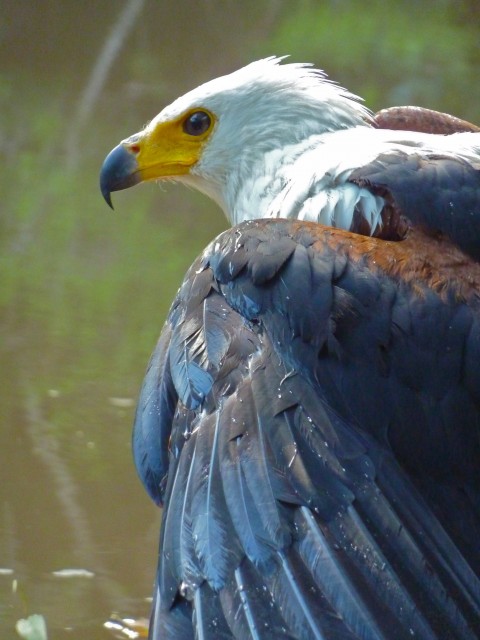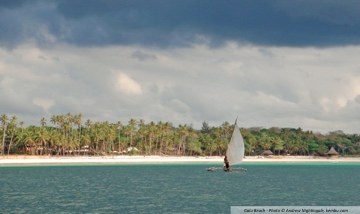Shimba Hills
This little but lovely national park is often overlooked. But the rare species I found here impressed me, and its proximity to famed Diani Beach makes it easy to combine with a trip to the coast

The Sable Antelope is large and stately, with white stripes down its face and imposing arched horns. It’s also highly endangered. The last remaining population in Kenya is less than 100 strong, and lives in the Shimba Hills.
Sable Antelope males are almost black, while the females are smaller and a rusty brown colour; their bellies, cheeks and chins are white; and while they’re mostly grazers, they have been known to lick salt and chew bones to collect minerals. Perhaps the most unexpected thing about them is, however, that they’ve been seen to confront lions with their razor-sharp horns, and even to kill them.
Yet the Sable Antelope is not the only unusual animal that has made its home on these forested slopes. Rare species of birds and mammals are found here in surprising numbers.
There’s the Elephant Shrew, whose long nose slightly resembles a trunk, and who is more closely related to an elephant than a shrew. Also known as a Jumping Shrew for its rabbit-like hops, this is one of the fastest small mammals and has been recorded doing speeds of over 28km per hour. Then there’s the Bushy Tailed Mongoose, whose bushy tail at full extension is almost the length of its body, giving it the appearance of being twice the size it is. Being not only nocturnal, but also the colour of night, these elegant mongooses are seldom seen. The Greater Galago, also known as a Thick-tailed Bushbaby, is best known for its alarming night-time shrieks, sometimes likened to a baby crying, and is also known to spit, growl and scream. Small and beady-eyed, these nocturnal creatures leap like monkeys through the trees, but perhaps their oddest characteristic is that the second toe of their hind leg has a claw that they use, predominantly, for grooming.
Other creatures found here are lumbering elephants who manage to hide their bulk surprisingly well in the bush; graceful black-and-white colobus monkeys who can be seen leaping from tree to tree; scaly monitor lizards that feast on small reptiles, small mammals, fish, birds and eggs; and nocturnal Fruit Bats, also known as Megabats, that dangle upside-down locating food with their keen sense of smell.
Rare birds, too, flock here in numbers that are unexpected. Localised species with beautifully evocative names include the Red-necked Spurfowl, also known as the Red-necked Francolin; the Croaking Cisticola, the largest of the Cisticolas known for its frog-like croak; and the vivid, crimson Zanzibar Red Bishop.
So what is it that draws these rare species to the Shimba Hills? Perhaps it’s the wide variety of habitats that this national reserve has: coastal rainforest, woodland and grassland. Or perhaps it’s the extraordinary plant biodiversity: of the 159 rare plants in Kenya, over 50% are found here, including cycads and orchids. Or perhaps it’s the beauty of the region, with its many viewpoints overlooking the Mwaluganje Forest, its rushing river, and the lovely Sheldrick Falls.
Whatever it is, there’s no doubt that this, one of the largest coastal forests in East Africa, deserves a visit. Whether you come for a day from Diani, or stay for a week, there’s plenty to feast the eyes on in the Shimba Hills.
Where to stay
Shimba Hills Lodge
A treehouse overlooking a waterhole, this owner-managed lodge has two suites, 22 twin rooms and 5 triples. A wooden treetop boardwalk leads from the lodge into the forest; on a platform at the end sundowners or candlelit dinners can be served.
Sable Valley Treehouses
These two romantic treehouses are open to the forest, have outdoor Jacuzzis, and their double beds can be rolled onto the deck for sleeping under the stars.
KWS Sable Bandas
The four simple rondavels, managed by the Kenya Wildlife Service, share a communal kitchen and outdoor barbecue, and have lovely views over the forest.
Camp Muhaka
Operated by Camps International, this camp is for young people who want to volunteer to work with the local community and support conservation efforts in the area.
Tamara Britten, 04 January 2019
Published also in: Coastal Footprints
About the region
South Coast

The South Coast is known for its long attractive beaches, vibrant night life, marine national parks, coastal national parks and remote islands. Highlights include Diani Beach, Kisite Mpunguti Marine Park, Shimoni Caves, Shimba Hills and Mwaluganje Elephant Sanctuary.
Read more about South Coast